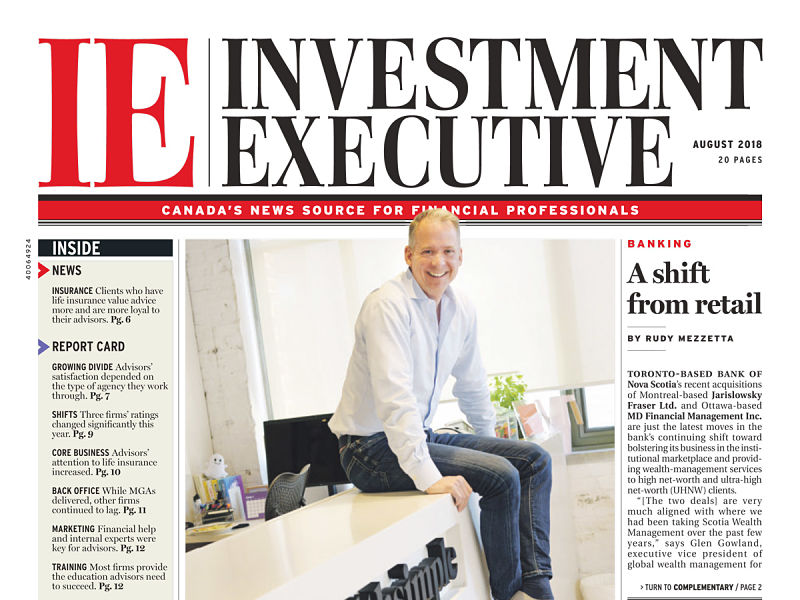
Jean-François Courville aims to expand Toronto-based Wealthsimple Inc.’s footing in the business-to-business (B2B) market significantly. He took on the role of CEO of Wealthsimple For Advisors in May.
Currently, there are more than 300 financial advisors – including certified financial planners and advisors who work at exempt-market dealers, mutual fund dealers and insurance agencies – using the robo-advisor platform of Wealthsimple For Advisors’ fintech parent.
Wealthsimple For Advisors launched in 2016. As part of the service, the parent robo-advisor platform manages clients’ investment portfolios while advisors focus on the relationships with those clients.
Although Courville won’t reveal how much of Wealthsimple’s more than $2 billion in assets under management (AUM) is on the firm’s B2B platform, he notes that Wealthsimple For Advisors is growing rapidly – and is a vital part of the larger organization.
“Wealthsimple For Advisors is becoming a more meaningful part of the overall mix,” says Courville. “I’ll make a bold prediction that it’s going to be at least as significant, if not larger than the direct-to-consumer business over time because of the sheer volume of people who [work with advisors].”
Courville will focus on bringing financial planners to the B2B platform, as well as advisors and dealers that operate on the mutual fund side of the advisory business. And Wealthsimple For Advisors may apply to the Mutual Fund Dealers Association of Canada for a dealer licence, a step that would allow Wealthsimple For Advisors to offer its B2B platform on a white-label basis to advisors, who could run their own businesses through it.
Financial planners who are comfortable in leaving the investment management to Wealthsimple are a natural fit for the B2B platform, Courville says, because they focus on the big picture of their clients’ goals and finances rather than on stock-picking.
“[Advisors] who want to differentiate themselves through the relationship, through [financial] planning, through their quality of service and their communication, and who will have the time to do that are going to be the ones who are most attracted to our platform,” says Courville. “Frankly, that’s the future of our industry.”
Eventually, Courville also will target advisors licensed by the Investment Industry Regulatory Organization of Canada and portfolio managers to join Wealthsimple For Advisors.
Looking further out, Courville plans to take the B2B platform to Wealthsimple’s international offices in the U.S. and U.K. The latter market, in particular, is a logical one for Wealthsimple For Advisors because of the fallout of the regulatory changes resulting from the implementation of the retail distribution review there, which created a “hollowing out on the advice front,” Courville says.
In the meantime, Courville is focused on the firm’s efforts at home. In fact, he argues that Canada is the best market in which to build a bridge between traditional financial services and fintech firms first because of changing client expectations and Canada’s evolving regulations.
“These next five years are crucial,” Courville says. “So, for us to get it right at all as a company, we have to get it right here in Canada [first] because of those ingredients.”
Courville is no stranger to building businesses in the financial services sector. In his previous roles, he played a leading part in helping Boston-based State Street Global Markets LLC’s Canadian division open an office in Montreal and helped Toronto-based Royal Bank of Canada (RBC) open its first innovation hub.
Courville’s career in the financial services sector began in 1991, when he traded currency options at Montreal-based National Bank of Canada and quickly fell in love with the adrenaline and buzz of the trading floor. In 1994, he made his first jump across the pond, professionally, moving to London to expand National Bank’s foreign-exchange desk.
After Courville’s return from London almost two years later, he was approached by State Street, which piqued his interest with its plans to open a Montreal office and create a new way of doing business through the use of data.
“We came into a room like this,” says Courville, gesturing to the size of a boardroom at Wealthsimple’s head office, “and had to buy phones, computers, faxes from scratch. [The business] turned into the largest institutional foreign-exchange platform in the country.”
Eventually, Courville moved up the ranks at State Street to become its CEO; by 2007, he decided to move on to another challenge – this time at Toronto-based Manulife Asset Management Ltd. (MAM). Under Courville’s direction, MAM grew to hold approximately $230 billion in global AUM, up from $95 billion, with offices in 17 countries.
Then, in 2013, Courville decided to take on the role of executive vice president and chief operating officer of RBC’s wealth-management division. In that role, he had an opportunity to oversee large technology projects and see how they work within RBC’s wealth- management operations.
In fact, Courville had a hand in establishing the bank’s digital agile lab, the aforementioned innovation hub, which led to the launch of RBC MyAdvisor. That online advice platform, in turn, connects clients to an advisor digitally.
Says Courville: “I always like pushing the envelope a little bit.”
Looking to the future in his new role with Wealthsimple For Advisors, Courville believes he is well positioned to help build a bridge between traditional financial services models and new ones being brought about by technology.
“Building that bridge well is probably going to be one of the more intricate parts of my team’s job,” says Courville. “We’re going to be really happy as we deploy our technology in the advice market. We’re going to be really, really happy when we’re able to bring the industry to an innovative phase.”